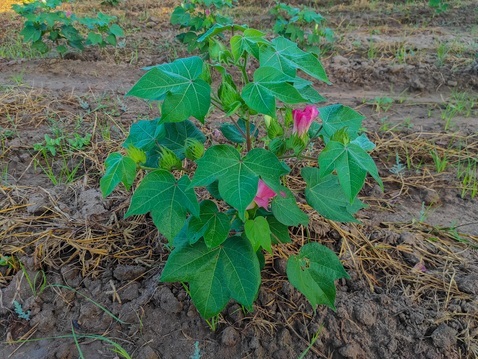
 Data Structure
Data Structure Networking
Networking RDBMS
RDBMS Operating System
Operating System Java
Java MS Excel
MS Excel iOS
iOS HTML
HTML CSS
CSS Android
Android Python
Python C Programming
C Programming C++
C++ C#
C# MongoDB
MongoDB MySQL
MySQL Javascript
Javascript PHP
PHP
- Selected Reading
- UPSC IAS Exams Notes
- Developer's Best Practices
- Questions and Answers
- Effective Resume Writing
- HR Interview Questions
- Computer Glossary
- Who is Who
What Is Marker Assisted Selection (MAS)
MAS - An Overall Understanding
Marker-assisted selection (MAS) is a molecular breeding technique that enables breeders to make informed decisions about which individuals to select for future generations. The approach involves using molecular markers, such as DNA sequence variations or protein polymorphisms, to identify traits that are associated with desirable phenotypes.
MAS has become an essential tool in modern plant and animal breeding, enabling the development of crops and livestock that are better suited to the changing demands of consumers and the environment.
History of MAS
The use of molecular markers to assist with selection in breeding dates back to the 1980s when scientists discovered that differences in DNA sequence could be used to identify variation between individuals.
The first applications of MAS were in plant breeding, where markers were used to identify traits such as disease resistance, yield potential, and stress tolerance. As the technology became more advanced, MAS was applied to animal breeding, where it has been used to select traits such as milk production, growth rate, and meat quality.
How does MAS work?
MAS works by identifying regions of the genome that are associated with desirable traits. These regions can then be used to select individuals with the desired trait(s) for breeding. The process typically involves four main steps ?
Identification of Molecular Markers
This involves identifying markers that are associated with the trait(s) of interest. The markers can be derived from a variety of sources, including DNA sequence variations, protein polymorphisms, and gene expression levels.
Marker Genotyping
Once the markers have been identified, individuals are genotyped to determine which markers they carry. This is typically done using PCR (polymerase chain reaction) or other DNA-based methods.
Marker-Trait Association Analysis
This involves analyzing the data to determine which markers are associated with the trait(s) of interest. Statistical methods are used to identify the markers that have the strongest associations with the trait(s).
Selection of Individuals for Breeding
Finally, the individuals with the desired markers are selected for breeding. This can be done using a variety of breeding methods, including the selection of individuals with the desired markers for traditional breeding, or using techniques such as genetic engineering to introduce the desired markers directly into the genome.
Benefits of MAS
MAS has several benefits over traditional breeding methods. First, it enables breeders to select traits that are difficult or impossible to observe directly, such as disease resistance or drought tolerance.
Second, it can speed up the breeding process by allowing breeders to select desirable traits at an earlier stage in the breeding cycle.
Third, it can reduce the number of individuals needed for breeding, as only those with the desired markers need to be selected. Fourth, it can increase the precision of breeding, as markers can be used to select specific alleles that are associated with desirable traits.

Applications of MAS
MAS has been widely applied in plant and animal breeding, with applications ranging from crop improvement to livestock production.
In plant breeding, MAS has been used to develop crops that are resistant to pests and diseases, that have higher yields and are better suited to changing environmental conditions such as drought or heat stress.
In animal breeding, MAS has been used to select traits such as milk production, meat quality, and growth rate.
MAS has also been applied in conservation biology to preserve endangered species. By identifying genetic markers that are associated with fitness or adaptation, MAS can help conservationists to identify individuals or populations that are most likely to survive in changing environmental conditions.
Challenges of MAS
While MAS has many benefits, it also has several challenges.
First, the process can be expensive and time-consuming, particularly when large numbers of individuals need to be genotyped.
Second, there is a risk of selecting traits that are not desirable or that have negative consequences, such as reduced fertility or disease susceptibility.
Third, the use of MAS can also lead to a reduction in genetic diversity, as breeders tend to select a limited set of desirable markers. This can increase the risk of inbreeding and reduce the ability of populations to adapt to changing environmental conditions.
Finally, the use of MAS can raise ethical concerns, particularly when it involves genetic engineering or the selection of traits that are associated with animal welfare issues.
Despite these challenges, MAS remains a powerful tool for plant and animal breeding. Advances in genotyping technologies and statistical analysis methods have made the process faster and more cost-effective while increasing our ability to identify desirable markers.
In the future, MAS is likely to become even more important, as breeders face increasing pressure to develop crops and livestock that are more resilient to climate change, more sustainable, and more ethical.
Conclusion
Marker-assisted selection (MAS) is a powerful tool for modern plant and animal breeding. By identifying molecular markers that are associated with desirable traits, breeders can select individuals for breeding that are more likely to have the desired phenotype.
MAS has many benefits, including the ability to select for traits that are difficult or impossible to observe directly, to speed up the breeding process, and to increase the precision of breeding.
However, the use of MAS also poses several challenges, including the
Risk of selecting undesirable traits,
Reducing genetic diversity, and
Raising ethical concerns.
Despite these challenges, MAS remains an essential tool for breeders, enabling the development of crops and livestock that are better suited to the changing demands of consumers and the environment.

